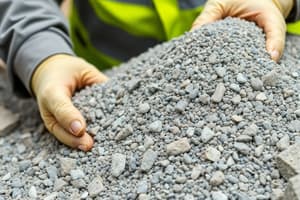Podcast
Questions and Answers
What is the recommended proportion of cement, sand, and coarse aggregates in the method described?
What is the recommended proportion of cement, sand, and coarse aggregates in the method described?
- 1n:2n (correct)
- 1:1:2
- 1:3:6
- 1:1:3
Why is very coarse sand or very fine sand considered unsatisfactory for making concrete?
Why is very coarse sand or very fine sand considered unsatisfactory for making concrete?
- They lead to lower strength concrete
- They are difficult to mix with cement
- They require more water for fluidity (correct)
- They result in harsh bleeding and segregation
What impact does the grading of fine aggregates have on the workability of concrete?
What impact does the grading of fine aggregates have on the workability of concrete?
- Significant impact (correct)
- Slight improvement
- No impact
- Increased strength
Why is crushed sand becoming more popular in the concrete industry?
Why is crushed sand becoming more popular in the concrete industry?
What type of sand is recommended for good workability in concrete?
What type of sand is recommended for good workability in concrete?
Which mix is suitable for use in foundations?
Which mix is suitable for use in foundations?
What is the main disadvantage of using ordinary crushed sand in concrete production?
What is the main disadvantage of using ordinary crushed sand in concrete production?
Why is the grading of natural fine sand not always ideal?
Why is the grading of natural fine sand not always ideal?
What characterizes natural fine sand that makes it preferable for concrete work?
What characterizes natural fine sand that makes it preferable for concrete work?
Which type of mix is recommended for use in columns and beams?
Which type of mix is recommended for use in columns and beams?
Flashcards are hidden until you start studying



